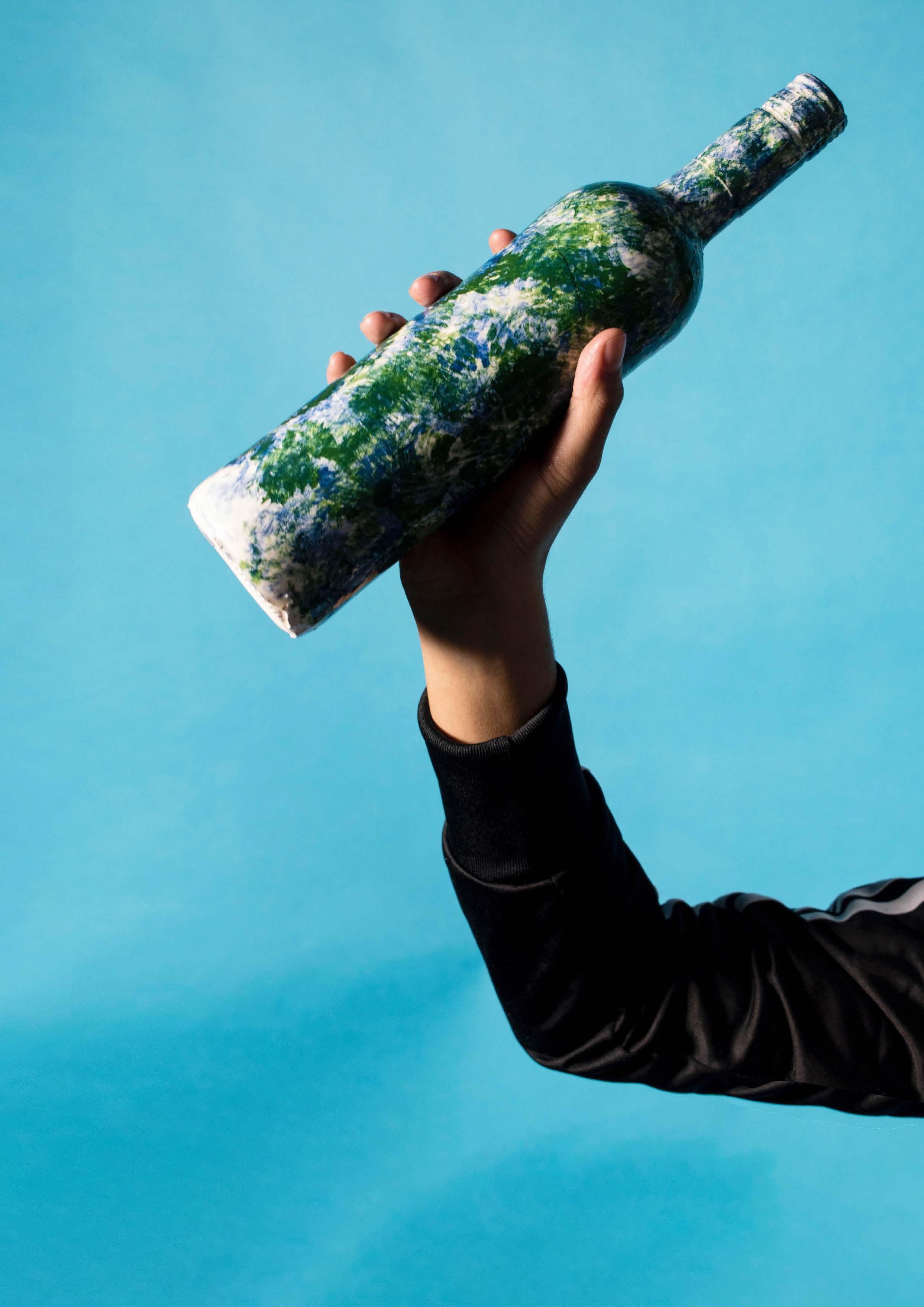
37 minute read
26 CLASS OF 2020
CLASS OF 2020 New art in extraordinary times
Before lockdown, before the new reality we are all adjusting to, we set out to talk to final-year students across the UK, from Glasgow to Plymouth, Leeds to London. Eight a-n members on the 2019-20 Writer Development Programme were commissioned to interview students, and in the pages that follow you’ll find a series of eight short Q&As (longer versions can be found at www.a-n.co.uk/degree-shows). Conducted in March, most of the interviews were done in-person at a time when universities were open and physical degree shows were still going ahead. That has now all changed – the students’ ideas and ambitions, however, remain just as relevant, vital and inspiring. Alongside these Q&As are a selection of works by other graduating artists. And, continuing our celebration of the Class of 2020, we also speak to course leaders who share their thoughts on the art their students are making at this most extraordinary time.
Advertisement
Charlotte Guérard (BA Fine Art Painting) makes mixedmedia abstract paintings defined by dynamic, gestural brushstrokes, puddles of bright colour and the odd panel of fabric. Her work is guided by an intuition for colour, gesture and form; coatings of paint, paper or textile collectively speak to the ‘history’ of a canvas in action. What is your background and why did you choose to study at Brighton? I’m originally from France; I came to England four years ago. I started by doing a foundation course and after that came to Brighton. I remember the open day and the person who presented the course talked about how painting is so broad and you can do so much stuff with it. It made it feel like quite an expanded field. How has your practice evolved during your time at university? I got introduced to abstract art when I came to England and saw the abstract expressionist show at the Royal Academy of Arts in 2016. I walked in and it felt so important. From there I started painting a lot like the abstract expressionists; in first year I was really looking at Willem de Kooning. As it evolved, colour became the initial part of my painting. Recently, because my work has become more about shapes and composition, I was looking at the British abstraction movement – Roger Hilton, Patrick Heron, etc. Now it’s like a big mixture of all kinds of influences. What kinds of materials do you use? At the moment, collage is the only mixed media that I am using. I paint mainly with acrylics. I’m really digging deep within a small amount of materials and seeing what I can do, how different it can appear on the painting. I had a solo show last year and had to get 17 paintings ready for it. I used paintings I’d done already and stretched them, cut them, and just pasted them back together. I’m really into layering, and having a narrative through the layers. The story of the painting happens when I’m creating it in the moment.
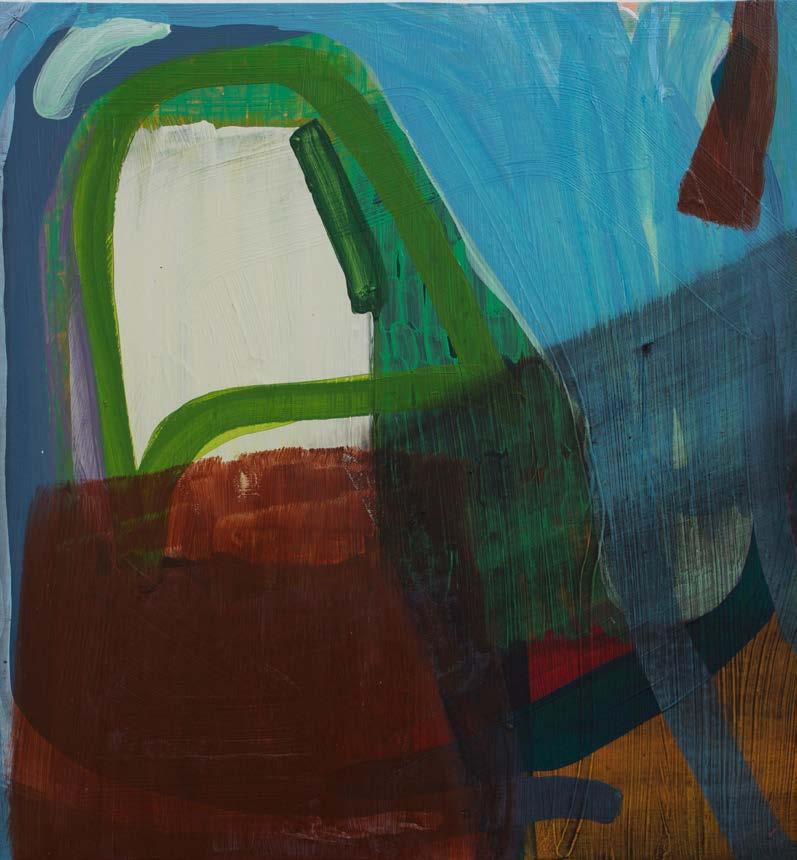
1
Charlotte Guérard (University of Brighton), Antagonist, 54x54cm, acrylic on canvas, 2019
2
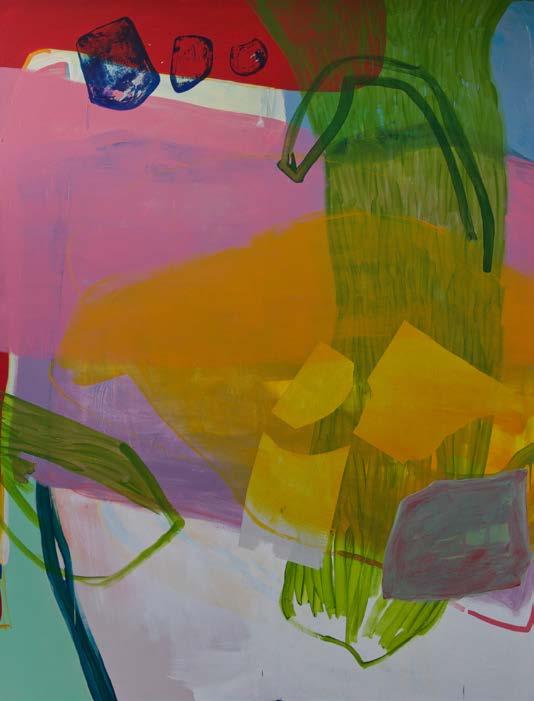
3
Charlotte Guérard (University of Brighton), installation shot of ‘Notch’ exhibition at the Fishing Quarter Gallery, Brighton, March 2020
3

Have you always worked on such a large scale? I do tend to work larger scale, although for a recent show I produced a series of four small-scale paintings. Small is a really good challenge; it’s like you don’t want to overdo the marks, overdo the layers – but you also want to have something to show for it. Do you see your paintings as sculptural? Yes. I think that as well as the shapes, the colours, and the material, the gesture and the movement is a massive part of it. It’s like a performative act. This becomes an object or an archive of my gestures, something that happened in my body, separate to what would have happened in my head. I’m interested in the different ways you can encounter abstract paintings. I went to see Vivian Suter’s work at Tate Liverpool, and she hangs unstretched canvases in the gallery on strings. These pieces are massive, but everything is so delicate. It’s really light, and you can imagine, if one of them was stretched on the wall, the weight it would have and how completely different it would appear. I think that is another choice to be made in terms of how you want to show the painting. I think with abstract painting, that’s definitely something that you have the opportunity to explore. You can be quite experimental with that.
Interview by Kitty Bew. For a longer version of this Q&A, visit www.a-n.co.uk/degree-shows
Sculpture and Environmental Art (BA Hons Fine Art) student Jack McElroy has a socially-engaged practice which leans more on the environmental than the sculptural. For his degree show, he planned to cut through the institutional space of the show, literally, with an indoor-outdoor stage wedged through the building. McElroy was determined to use it as a way to bring people together and to collaborate with others. And, crucially, to have a good time. Can you tell me a little about your work leading up to the degree show? I tend to make artworks as events, rather than objects. I recently put on an alternative Burns Night with contemporary artists, drag artists and poets, which also looked at how Burns events are funded. I’m not a DJ, not a drag queen, not a comedian, so I have to have all these other people there to make it happen. I’m a facilitator, almost. So if you have that kind of practice, and you study environmental art, and the degree show is these four white walls – how do you deal with that? That kind of freaks me out. I’m conflicted about just putting documentation up, just photos on the wall. So the plan is to put up a stage that people can perform on. The idea is to have this stage that interferes with the building in some way, and on the night I want to create a bill of acts, performances and events centred around ‘wellbeing’ – which for me is going to gigs, going to see drag acts, doing yoga. And when the stage is empty? I want it to be looked at as a sculpture as well. An installation. It has this illusion that it’s cutting through the building, or the building is cutting though the stage. They’ll align so it looks like they’re joined up. You can come up and stand on it, and see the rest of it out the window. It is site specific, so it can only work in certain spaces of the building. Do you see the degree show as a sampling, as an end point, or more of a mid-point? I’d say mid-point. I was worried at the start I’d have to make an artwork
2
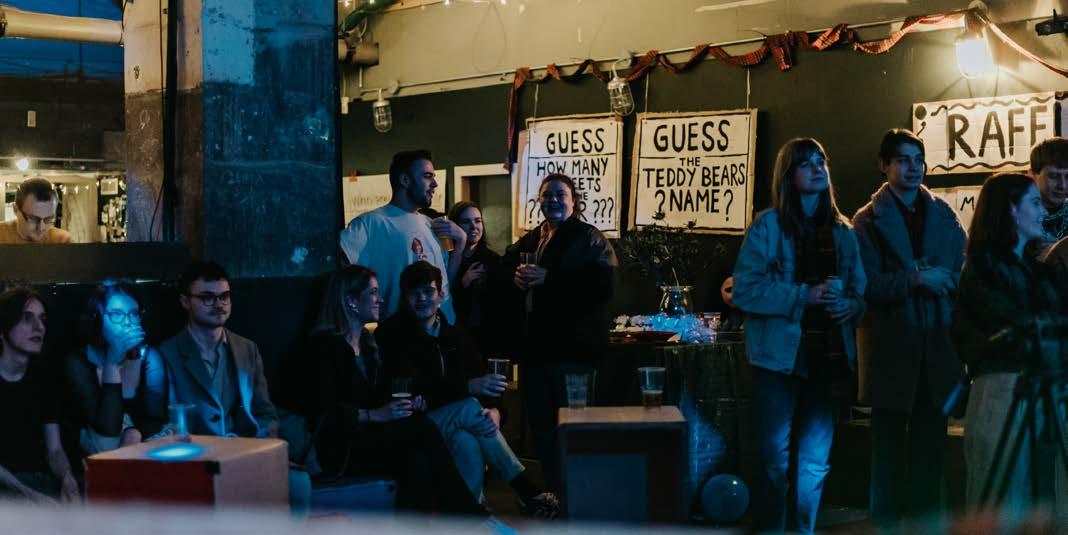
that encapsulates all my interests over the last four years. But how can you? Is the need to document your work for crits and tutorials ever a problem? It’s usually a tricky one. You never get a full sense of the work. You need to have been at that event to know what it was like. That’s something I’ve maybe learned most through the course, how best to document my work, experimenting with ways of documenting which are more appropriate. What do you feel the course could have given you more of? Maybe it’d be helpful to know more about the processes and permissions you need to go through, especially with environmental art, when you’re doing things in public. Maybe a bit of ‘How do I get a job?’. But I feel ready to leave art school. I used to feel really nervous about it, but now I’m happy to go! Before I went to art school I thought, ‘Oh you need to get a gallery’. Now, because I work with communities and I’m interested in people who think they aren’t interested in art, that’s not so important.
Interview by Jamie Limond. For a longer version of this Q&A, visit www.a-n.co.uk/degree-shows
Degree show: A digital showcase for 2020 graduates will go live on 29 May and remain online for 12 months.
www.gsa.ac.uk

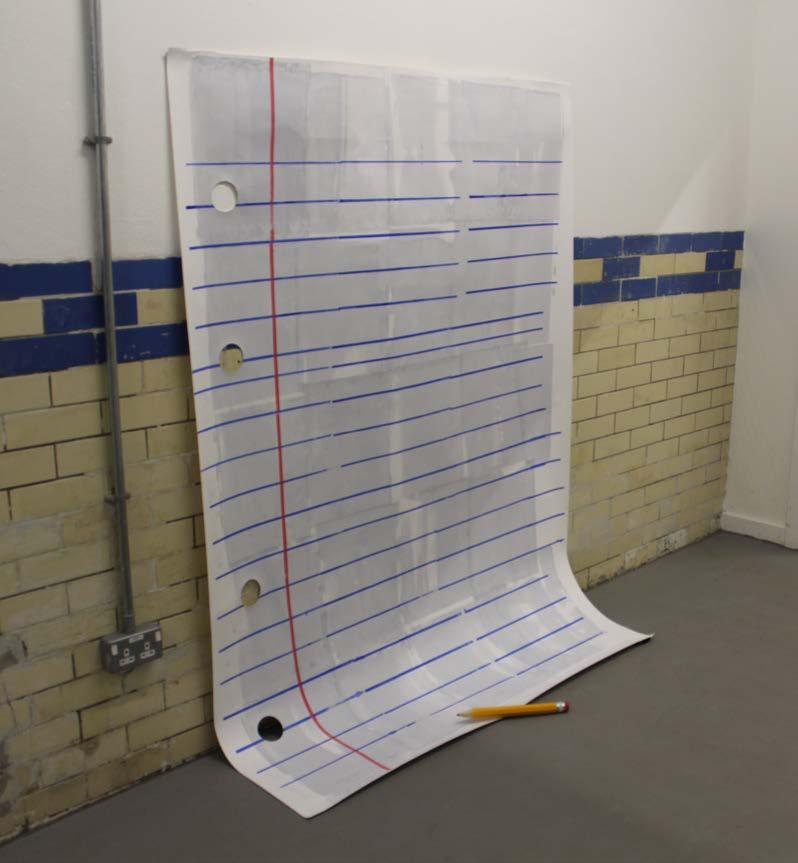
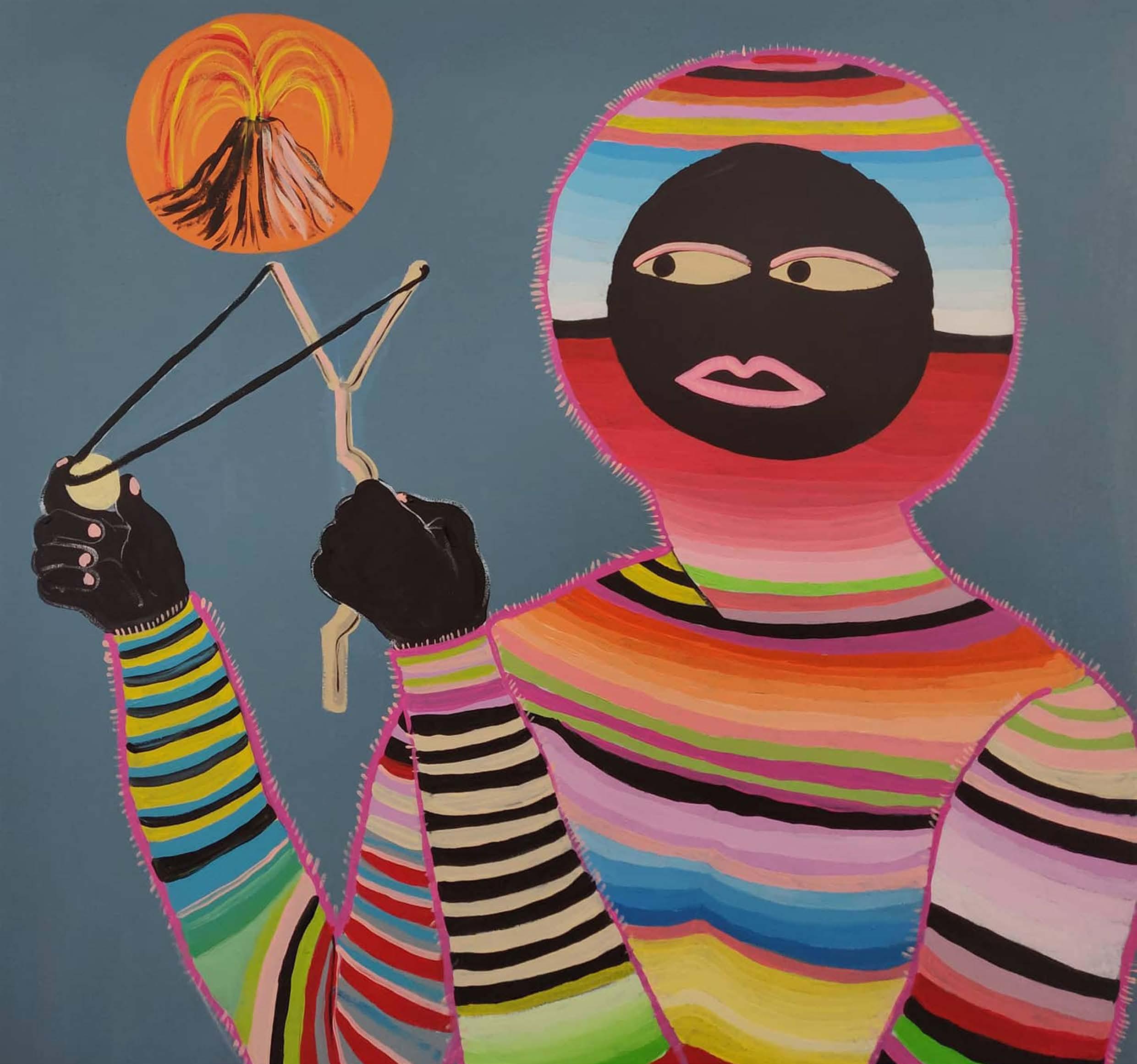
Rithika Pandey
Carmarthen School of Art, Coleg Sir Gar
Rithika Pandey (BA Fine Art: Painting, Drawing and Printmaking) says of her work: “I am yearning for a spiritual, perhaps enlightened escape.” Working in painting, collage, animation and installations, her approach combines the personal, the mythological and the earthly – “a spectrum of psycho-spatial exploration”. She adds: “I am also gazing into the contemporary socio-political realities surrounding displacement, migration, women’s cultural and economic states, and most importantly mental health.”
Degree show: An online degree show is expected in June, while future plans for a physical show are to be confirmed.
www.colegsirgar.ac.uk
London artist Preeti Shannon Tak (BA Fine Art) creates large-scale, participatory installations that use imaginative role-play to encourage greater empathy and connection with ecological systems. Drawing on her studies into the global biodiversity of sharks and tropical coastal ecosystems, she hopes that this ecological understanding will lead to increased personal and environmental responsibility. How does studying subjects such as the biodiversity of sharks and tropical coastal ecosystems inform your artistic practice? My work is very driven by research. I take any chance I get to learn new things so that I can become confident exploring these topics. I was bored one summer – I had just achieved my scuba diver certification and was wondering where else that could take me. I have a passion for the natural world and its creatures throughout history, including sharks, so I decided to study them. When I started my Fine Art degree I realised that I can incorporate science and nature into my own works. Scientific data can be really hard to understand – visualising it can make it much easier to digest. Why choose art as a medium to explore these ideas as opposed to a scientific field? I’ve always said that if I wasn’t an artist I would be a scientist. But why can’t I be both? The tutors at The Cass helped me realise that it’s OK to combine my passions. Is there also a personal, emotional element to your work or do you see yourself as, like a scientist, accumulating and visualising data? A bit of both. As a human in a modern capitalist society I feel very responsible for the state of the Earth. I often spiral into an existential crisis about the environmental situation,

2

while remaining hopeful for a sustainable future. These emotions can’t help but permeate my work. In the process of making, I often feel like a researcher. I must draw, photograph and observe ideas in order to understand them in every way possible. Your work often takes the form of installations which encourage audience participation. Which of these do you feel has been the most ‘successful’? Future Fossil (2019) was a large dirt mound in the middle of the studio, created with layers of sand and clay slip. Within each layer was a different type of waste: the layers represented the time each type of rubbish would take to biodegrade – if at all. This was mixed with a couple of real fossil finds. Around it were gloves, goggles, masks and tools for excavation; the audience was asked to become the fossil finder. Whatever they found they could keep, but to their dismay, this would mostly be the rubbish we are leaving around today. So many people got involved that the mound looked unrecognisable. It was great! I’d say this was successful because the many participants needed very little prompting to get involved. I had a lot of people come up to me that night and say what a wake-up call it was as they realised that today’s waste could be tomorrow’s fossils. What are your plans for the degree show? I am planning to make a walk-through biosphere that mimics the biome of a rainforest. Everything will be controlled to the point where it can sustain itself for a period of time, including temperature and humidity. Real plants would be used as it would act as breathing space. Conceptually it will be very dystopian, but not visually. The materials used for this project will be reclaimed and recyclable.
Interview by India Nielsen. For a longer version of this Q&A, visit www.a-n.co.uk/degree-shows
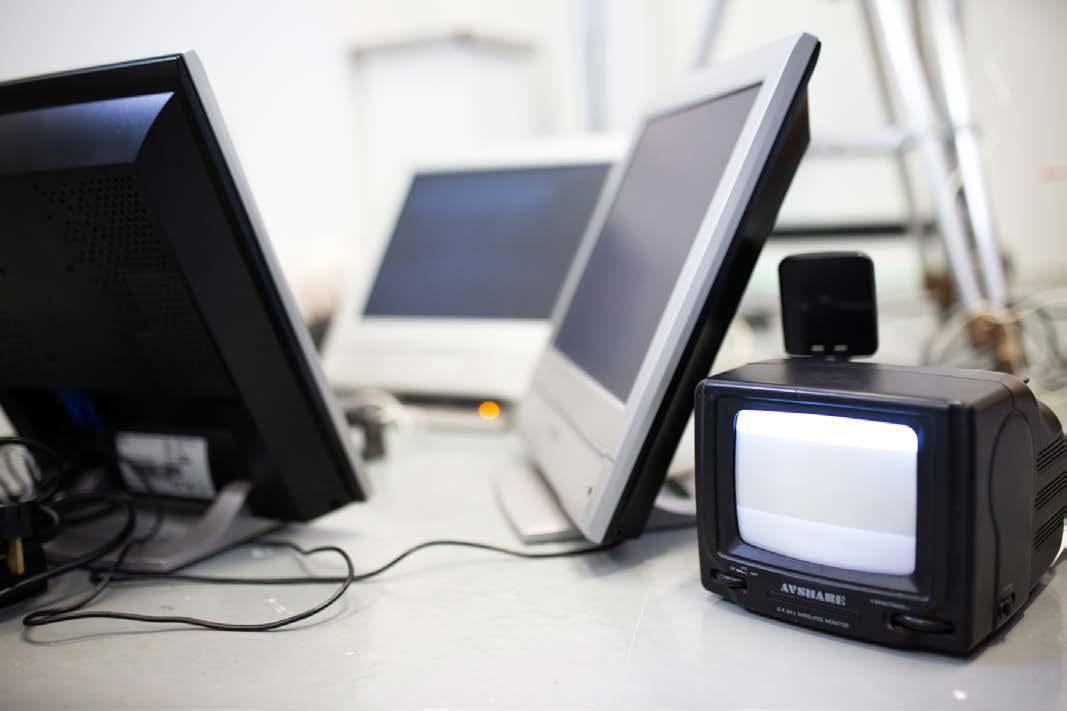
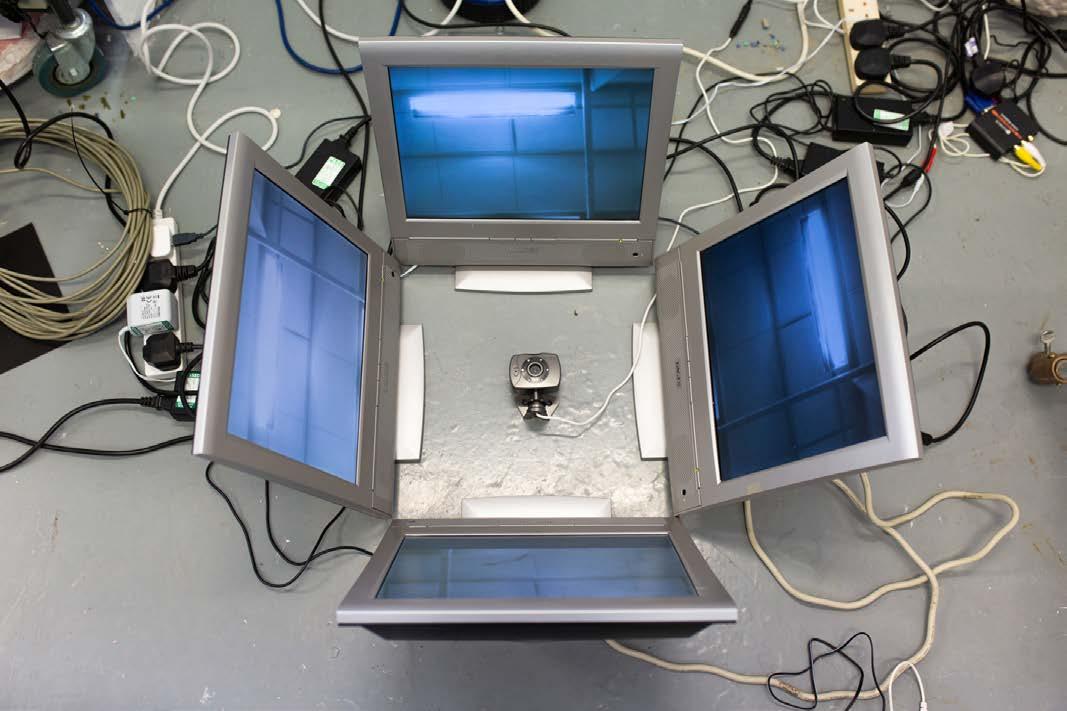
2
Archie Brooks
Leeds Arts University
Archie Brooks (BA Fine Art) is a video artist and collector of obsolete CCTV systems. He’s interested in exploring how we relate to screening and surveillance technologies, with an emphasis on audience interaction. Could you say a little bit about your practice? I’m trying to find new ways of looking at video. I want to look at it as a phenomenological object, or sculpture. I’m using screens as my medium, as a painter would use a paintbrush and paint. I like old technology, the quality of it. I’m interested in the idea that these monitors have already been watching and someone has watched them – they’ve had lives beyond what I’m doing with them now. I anthropomorphise my monitors a bit. I like to name them; I form a kind of bond with them. Can you talk about the four-monitor CCTV piece you’ve made? When people look into it they become part of the piece. It also changes the space they’re in because they’re thinking about it differently. But even when no one’s here it’s always working, it’s always looking. I’m working on a transparent plinth which will hold all the cables. I’m not into hiding how these videos are made because that’s part of it, the wires running out like a spider’s web. I love the hardware and the software, it’s all part of the art. I’m really interested in structural film and the materiality of video. Is audience interaction important to your work? Extremely important. The work is instigated by people looking at it and interacting with it. But I don’t want my work to be interactive in the sense where you invite participants directly, I want them to enter and already be inside, like an unwritten contract – by looking you’re automatically part of it. I’m also really interested in delayed feeds. You enter a space, the image on the screen looks the same as the surroundings but then you see yourself enter two minutes later, and it’s like that past is imprinted. Tell me about Durations, a video piece you’ve described as a study of ‘subjective time’. I’m interested in observation, the idea of being watched. In Durations it’s just the person and a camera – they sit in a space without stimuli for as long as they can endure. The shortest duration was 15 minutes and the longest was two and a half hours. So when we watch the video we’re reliving 20 different non-concurrent timelines, existing simultaneously on screen. I like to tell people about the work first before they sit for it – it creates the idea in their mind that in the future someone will be watching them. It creates anxiety. I feel like my work creates a lot of anxiety. How would you exhibit this piece as part of a degree show? I would love to show Durations in an enclosed box where the viewer is in the same scenario as the people in the video. They are sat in a chair watching the screen and they are being filmed on a live feed, so people outside the room can see them on a monitor. The viewer is part of the piece, like the participant, and I want to create that bond between them. There’s also a sense of being watched but not knowing how or who is watching. I think that ambiguity, when you’re being watched by a camera, is the sensation I’m trying to create. Interview by Joanna Byrne. For a longer version of this Q&A, visit www.a-n.co.uk/degree-shows Degree show: An online show, ‘Untilted2020’, will take place 30 June – 20 September 2020.
www.leeds-art.ac.uk
3
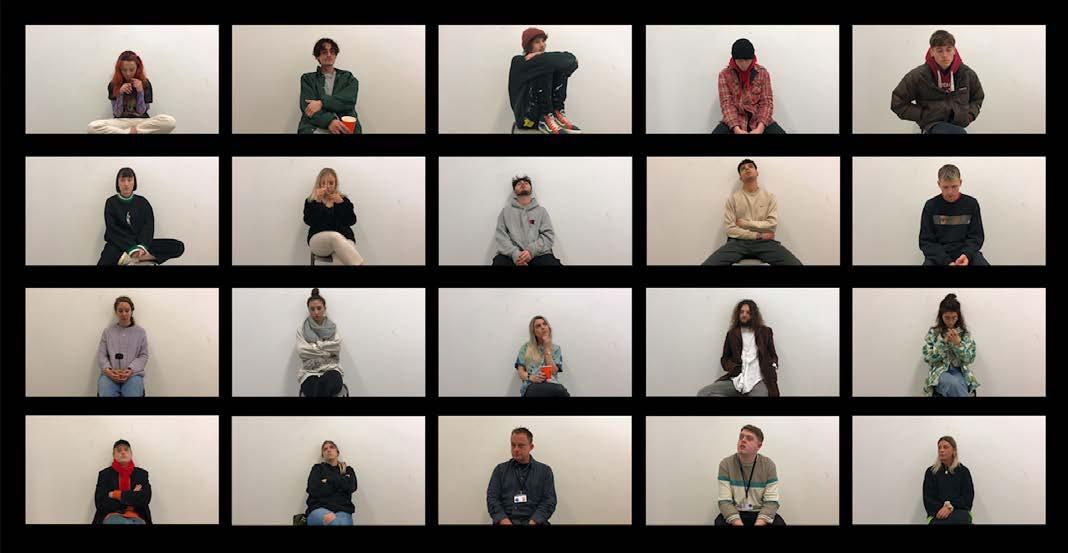
Jemma Jelf

MIMA School of Art and Design, Middlesbrough
Jemma Jelf (BA Fine Art) is interested in how we represent ourselves sexually and the way that attitudes to this are determined by factors such as gender, age, sexual orientation, background and religion. She makes work in various mediums, including sculpture, printmaking, photography and performance, often using recycled or found materials. She says: “By combining [the materials], I attempt to transform ordinary matter into something unexpected and thought provoking.”
Degree show: A website promoting the work of BA Fine Art students is currently being built, while a physical show for BA and MA students is planned in the new year.
www.tees.ac.uk/schools/mima
Working with materials such as plaster, soil and paper, Gwyneth Machin (BA Sculpture) focuses on our relationship with the Earth, from “the visceral feeling in landscape to the oppressive canyons of a cityscape”. Drawing on childhood memories and recent personal experience, she says of her approach: “I often return to a child-like curiosity in which I discover and rediscover the world. Imagination takes me down to the soil beneath buildings, the smallest amount of which can bring forth life.”

Degree show: This year’s show has been cancelled and ECA is ‘exploring alternatives’, details to be confirmed. www.eca.ed.ac.uk/event/eca-degree-show

Torin Baguley
Manchester School of Art
Torin Baguley is on the painting and print-making pathway of the Fine Art BA. He uses oil paint to “find” psychological portraits, drawing on imagery from obscure and humorous YouTube videos.
You’re from London, how did you end up choosing Manchester School of Art? I grew up in Watford, just outside London. I came here on a tour, fell in love with the studios, met some of the tutors, who were really intelligent people. That’s why I chose here. Where does the source material for your paintings come from? The imagery comes from several places: the film Stalker, Google images. But mainly I use YouTube video screenshots – only of weird, obscure videos with fewer than 10 views. I type in whatever I’m thinking about, like performance or pedantic videos or cosplaying, and then I click on ‘latest videos’. I use painting as a way of questioning the inherent weirdness of dressing up as a TV or video game character. What will happen if I elevate it by putting it onto canvas? There’s humour in taking something that many would click past, and putting it onto a solid frame, in rich oil paints.
Presenting and performing yourself is becoming more prevalent, to an extent where it ends up being pedantry or pure performance. I fear the larger, societal impact of that. I also think that there’s something really hilarious about the act of reaching to do something and just missing. That’s something I want to explore further.
In your statement you refer to ‘Notes on Metamodernism’ by Timotheus Vermeulen and Robin van den Akker. How does your work relate to this? I talk about the upfront lie: admitting you’re trying to be something else, and if people like it, they like it, including an ‘I’m-not-sure-I’m-going-to-succeed’ disclaimer. Escapism is great and lends a sense of complete control. But it can reach a limit where it’s quite a bad thing, like a vlogger overperforming themselves for the sake of others enjoying them as a character, not who they are. I want to search into that desire to be loudest, funniest and thinking that everything is fantastic. The current work still has a risible aspect in that it’s elevating the mundane to an art context. There’s something very sincere about taking the time to paint it. Between modernism’s grand narrative and its critique – post-modernism – metamodernism is about the act of doing, being in between, reaching and all the while expecting to fall short.
Once you have the image you want to work with, what does your process look like? I might start with a key idea and a set of motifs, but marks and gestures can transfer it into something else. It’s like sculpting with paint. I draw, or use watercolours, and I also draw onto the canvas with paint, loosely. What’s been your favourite response to your work? It was from a tutor. We were about to start talking about a piece, he looked at me and said, ‘Are you ready for me to tear it apart?’ I was like, ‘Yeah.’ For the next 10 minutes he picked apart every single thing about that painting. He absolutely destroyed it, and I loved it. I learnt more about my own painting and how to paint in those 10 minutes than from all the positive feedback I’ve ever had. I’ve completely fallen in love and gotten addicted to painting.
Interview by Valerie Zwart. For a longer version of this Q&A, visit www.a-n.co.uk/degree-shows
Degree show: An online exhibition (dates to be confirmed), will be followed by a series of shows in the art school once the building has reopened.
www.art.mmu.ac.uk
1
Torin Baguley (Manchester School of Art), Untitled, 56x103cm, 2019

2
Torin Baguley (Manchester School of Art), Mr Walker, 30x30cm, 2019
Charlotte Gittens (BA Fine Art) centres her practice on ideas of wellbeing and nurture, presenting sculptural forms as a touchstone for meditative and playful exercises. She has used workshops and installation to explore the therapeutic properties of objects, encouraging people to put their busy lives on hold.
What is the main focus of your practice? My work is about social relational engagement and how you can use materials or sculptures as a tool to connect with others. I like making organic forms that people can interact with – these sort of comforting blob forms which often have very human characteristics. What materials do you use? Are there any recurring motifs in the work? The colour orange! It’s a joyful colour and people are attracted to it. The shade I use is quite bright and artificial. For the degree show, I’m looking at how I can balance that against other colours and other forms. Colour is important, but how people engage with the sculpture is the main thing. As for materials, I started off with soft fabrics, a lot of felt and wool, but now I like to use things I just come across in the everyday. What sort of environment do you look for to stage your work? It needs to feel comfortable so that people can be themselves and engage with the work how they want to. I’ve only used quite institutional spaces so far, but I think it would really change if it was in public, the city centre, or maybe the Peak District. Recently I did a workshop as part of a 24-hour art event. We all picked up the blob together and moved it round, and then stood on it and bounced on it, and played with it. At one point we were all kicking it in the air and moving it round on our feet. It released a sense of joy.
Which artists or ideas have inspired your work? Lygia Clark is an artist who’s really influenced me. She looked at how using materials in relation to the body can be a therapeutic and healing experience. Faith is also a crucial influence. There’s a relaxed environment at church, you can come as you are, share where you’re at and receive support. How important is it to recreate that welcoming environment for visitors? I think it’s really important. It’s about you being able to bring your own way of playing and reflecting. You can have slow reflection in a contemplative space, but there is also a busy, physical and joyful element to the work. I’m still figuring out what I want the degree show to look like, but it will be along the same lines of sculptural interaction. Do people usually respond to your work in the way you expect? Yes and no. I had an exhibition in January where I put the orange blob in the corner, and a little row of orange earplugs on the wall, and then a film of me and two other course mates interacting with the blob. In the film we didn’t talk much, we just communicated physically. We were just focused on this orange blob, and it was therapeutic. I guess that feeling oozed out, because people found it a joyful thing to watch, and oddly relaxing. But when the sculpture is just sitting in a gallery space it’s quite difficult, because people often don’t want to touch art. I had to be like, ‘You can touch it, you can pick it up, you can play with it!’ They were like, ‘What, can I? Am I going to do something wrong?’
Interview by Orla Foster. For a longer version of this Q&A, visit www.a-n.co.uk/degree-shows
Degree show: A decision has yet to be made on whether a physical show will take place.
www.shu.ac.uk

1 2 3
Catherine Gittens (Sheffield Hallam University), Orange Blob, exhibition view, 2020


Martha Scott (BA Fine Art Sculpture) works primarily with everyday and mass-produced objects, exploring the materiality they hold. “Often through intuitive arranging and building, I explore the tensions and tenderness between the domestic and the industrial,” she explains. Her installation Triple Protection (For the Whole Family), for example, brings together carpet underlay, toothpaste, metal brackets, concrete blocks and other mundane materials. “These works often allude to traces of human actions and the suggestion of the body, such as the familiar squeeze of a toothpaste tube.”

Degree show: An online exhibition (dates tbc) will take place over the summer. ‘Pending access to buildings and permission to have gatherings’, there will be a physical showcase later in the year.
www.arts.ac.uk
1
Martha Scott (Wimbledon College of Arts), Triple Protection (For the Whole Family), detail, toothpaste, carpet underlay, concrete block, carrier bag, rope, metal brackets, metal clamp, print on paper, electrical tape, 2020.
In the work of Adonia Hirst (BA Fine Art), communication, intimacy and movement is explored through tactile sculpture that distorts the viewer’s perception of touch and interaction. Unsettling while also humorous, her use of textiles reflects gendered ideas of craft and making, while also being deeply personal. She says: “I use discarded fabric given to me by my mother, who is a curtain maker, and the process I use consists of a combination of skills I have learnt from female members of my family.”
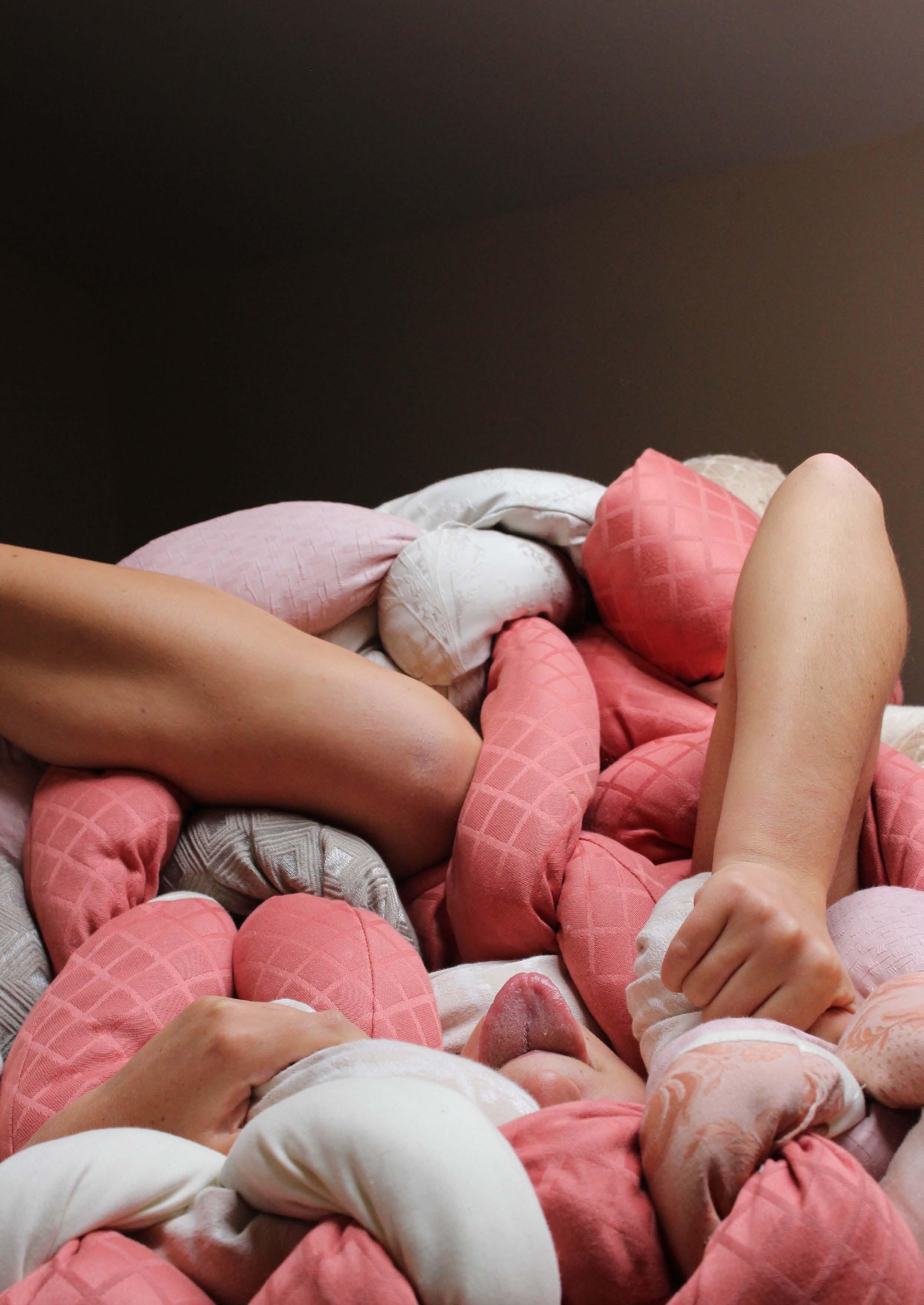
Degree show: A dedicated website showcasing students’ work is in development, with a physical show planned for later in the year. Students are currently profiling their work at www.instagram.com/newcastlefineart
www.ncl.ac.uk/sacs/fineart

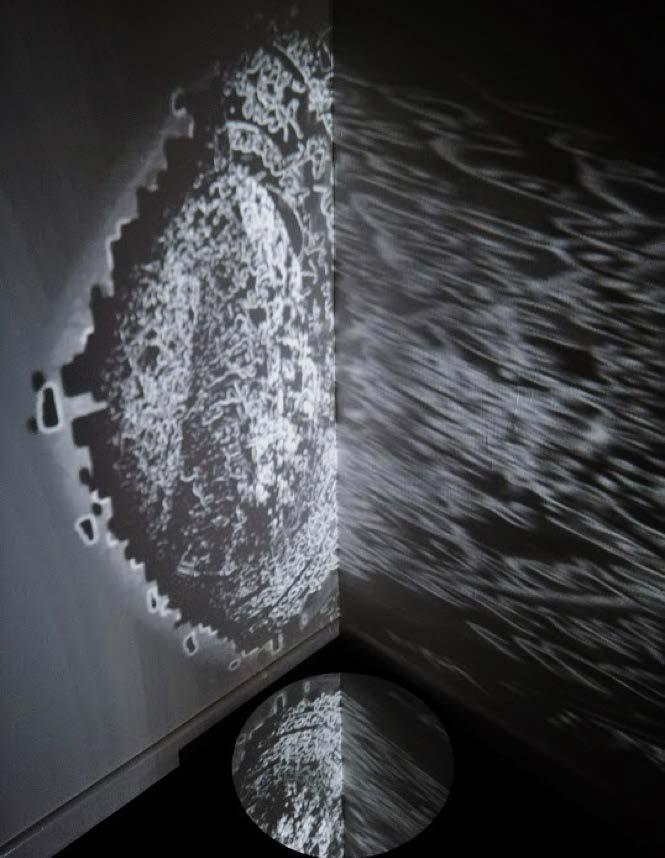
Molly McAndrews
University of Plymouth
Molly McAndrews (BA Fine Art) makes work that focuses on “the departure of thought from the body”. Using text, diagrams and digital technology, she creates installations that give visibility to a network of thought. Why is text so important to your work? I chose to study in Plymouth because of the library – it’s absolutely incredible! For me there was no other place I would rather be. But in my first week of university I lost half my sight. Luckily, the university has great software that will read photocopied pages to you. Words would get me thinking, but then in order to read and understand I have to make a visual product. Everything I read was really dense, and hard to take in by listening alone, so I would draw what I thought it looked like. For example, Being and Becoming is a diagram I made from the Gilles Deleuze text Difference and repetition.
2
Molly McAndrews (University of Plymouth) Looking Down, 2020
How has the way you work changed during your time at Plymouth? In my first year I started by automatic writing; letting ideas just simmer on a piece of paper. Afterwards I would think, ‘What shape does this thought take? It’s here, but can it be somewhere else?’ And then the writings began to overlap: things I’d written and things written by someone else. It felt like it was a collaboration because I let my thought and someone else’s thought unravel on to this field. Tell me about your investigations into the diagram, what you describe as “thought-to-matter assemblages”. How do you use photocopied pages of books and your notes? I put a light box behind them, or would scrunch up the bits of paper containing the words into little balls, overlapping them. Then I wanted to see what it would look like through a hole – maybe I was trying to use my eye in a different way. I used projection, cameras, sound, light in order to see things I wouldn’t have seen otherwise, for example the dust collected on sheets of cellophane. It’s a journey from my imagination, to my fingertips, to a machine, through a machine and out the other side in a digital existence. Your eye condition led you to be confined to the dark for several weeks, and then you discovered the philosopher and political theorist Jane Bennett’s theories on the vitality of things. How important was that? It changed everything. It created a whole new system for me to look into and I used touch so much more, and smell and things like that. Jane Bennett made me realise that light could be sculpture and that I could feel light. What are you planning for the degree show? I’m using my Being and Becoming diagram as a starting point, and thinking about where we connect to the thought network. At my last assessment I had four mirrors representing each person’s little bubble – little portals. They would spin round and I invited people to sit on the floor and ground themselves and breathe through their feet. And just experience their thoughts passing by, just over their heads... I’ve no idea what it will physically look like but I know what it will feel like. Did you come to Plymouth with this investigation already in mind? Oh no. I used to volunteer for a refugee rehoming business in Doncaster. My work was the fire I had about the fact I wanted the world to be a certain way and it just wasn’t. I needed to analyse what was going on in my own world and find my language.
Interview by Rachel Marsh. For a longer version of this Q&A, visit www.a-n.co.uk/degree-shows
Moving between abstraction and figuration, Lydia Makin (BA Fine Art) makes large paintings that brim with energy. Using a wide vocabulary of marks, she captures the fleeting moment, where nothing is solid or clearly defined. Her work bursts with drama, vibrant colours singing against the dark backdrops she favours. Have your four years at Slade been a positive experience? I’ve absolutely loved it. Coming to London was a change because I’m from the countryside, but I really like the fast-paced nature of life here. The tutors are brilliant; I found them incredibly helpful. Sometimes you do get a harsh tutorial, from a visiting artist or someone like that. It’s hard to swallow at the time because it’s so personal, but once you’ve digested what they’re saying, it’s actually very helpful. How has your work changed over the course of your degree? My work has just evolved, basically. I feel like there are fundamental things that have stayed the same. I’ve always been interested in the action of making a mark and loved big painting, exploring the effects that can be generated through working on different scales. The figure has gone from my work and come back. So, I feel like I’ve gone in a circle in many respects, but my brushstroke has always been there.
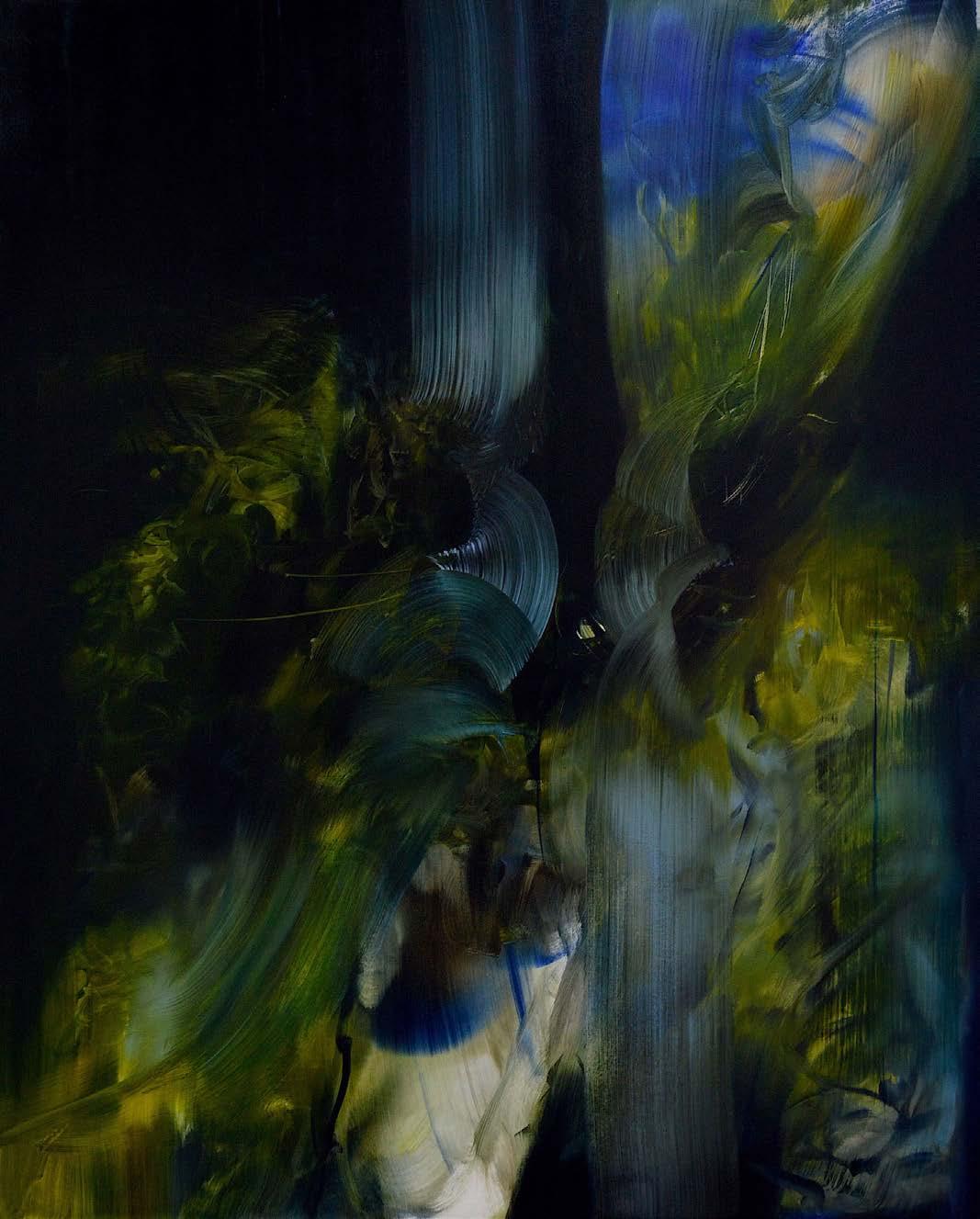
2
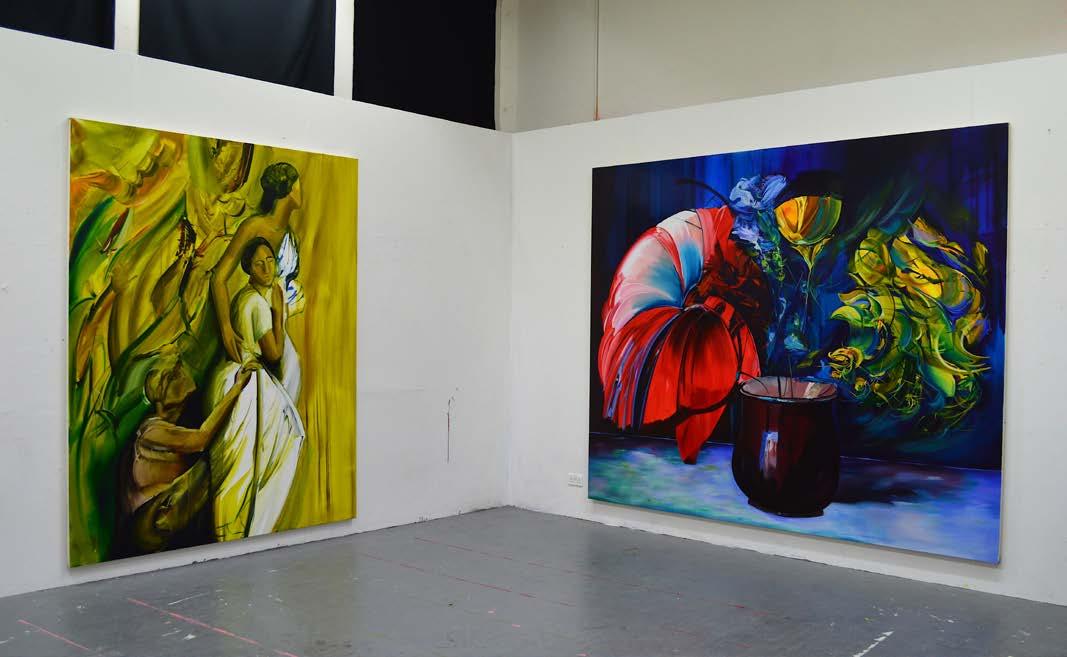
What do you look for in a painting? I’m very interested in the drama of a painting, the sense of being overwhelmed, and I think that coincides with the scale that I’m interested in. The first touch of the canvas was something that really excites me – the light and how the light comes through from the first touch. Do you have a clear idea of how a painting will look before you start? No, not necessarily. It can be very much a surprise. When the image isn’t quite there for me, I like to challenge [my original idea], which is why the paintings sometimes take more time. I’m trying to find something through the process itself. They can start off from the drawings [that I make, but] I find that when you work on them for longer, different things can arise out of them. I don’t want to spell it out to people. If you see figures emerge or the illusion of something else within the image, that fascinates me. What’s the relationship between abstraction and figuration in your paintings? It’s almost a completely different mind-set when I know there’s not going to be a figure. It’s a different way of thinking where I really take on the scale, because it’s a huge white canvas. And I feel like when I’m painting these images, it’s a reaction, something very simple and core. Sometimes [the figure] adds something – another dimension. What role does travel play in your work? When I travel and see things, they resonate with me. I felt that very much in Rome, where I went last summer because I was a teaching assistant for the Rome Art Program, with the Baroque. I loved the Bernini water fountains. I think I was attracted by the sensation of the water and how this might correspond to the sensation of making a stroke when painting. I went to the Prado in Madrid a few years ago and was drawn to the flow within a Rubens painting. Flow is an important part of my work. The fabric around his figures are like triggers in my head. Light’s very much part of my work too, I look at Goya a lot. I feel like when I’m painting, it’s a reaction to these experiences.
Interview by Isaac Nugent. For a longer version of this Q&A, visit www.a-n.co.uk/degree-shows
Poppy Jones-Little
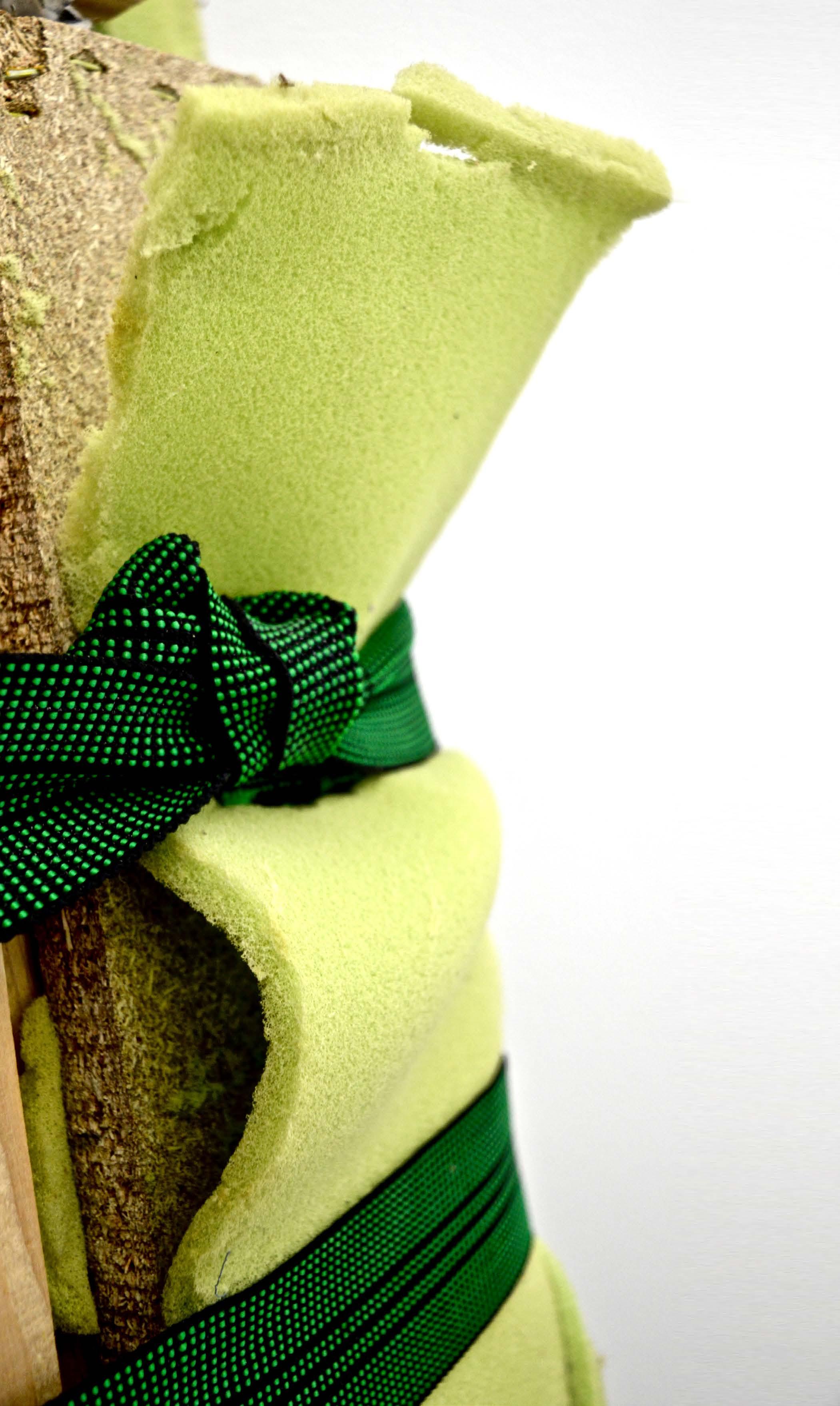
University of Leeds
“My praxis is centred upon the notion of ‘lumphood’,” explains Poppy Jones-Little (BA Fine Art (International)). “I strip away appearances, exposing the lumpen substances within.” Utilising found ‘waste’ materials, her approach is in part informed by a desire to make art that doesn’t impact on the environment. In exploring notions of form and function, her work finds intrigue and purpose in absence. She adds: “A lump exists at the cusp, it occupies a space within the outer limits of our recognition; it creeps in without intention to denote a non-thing.”
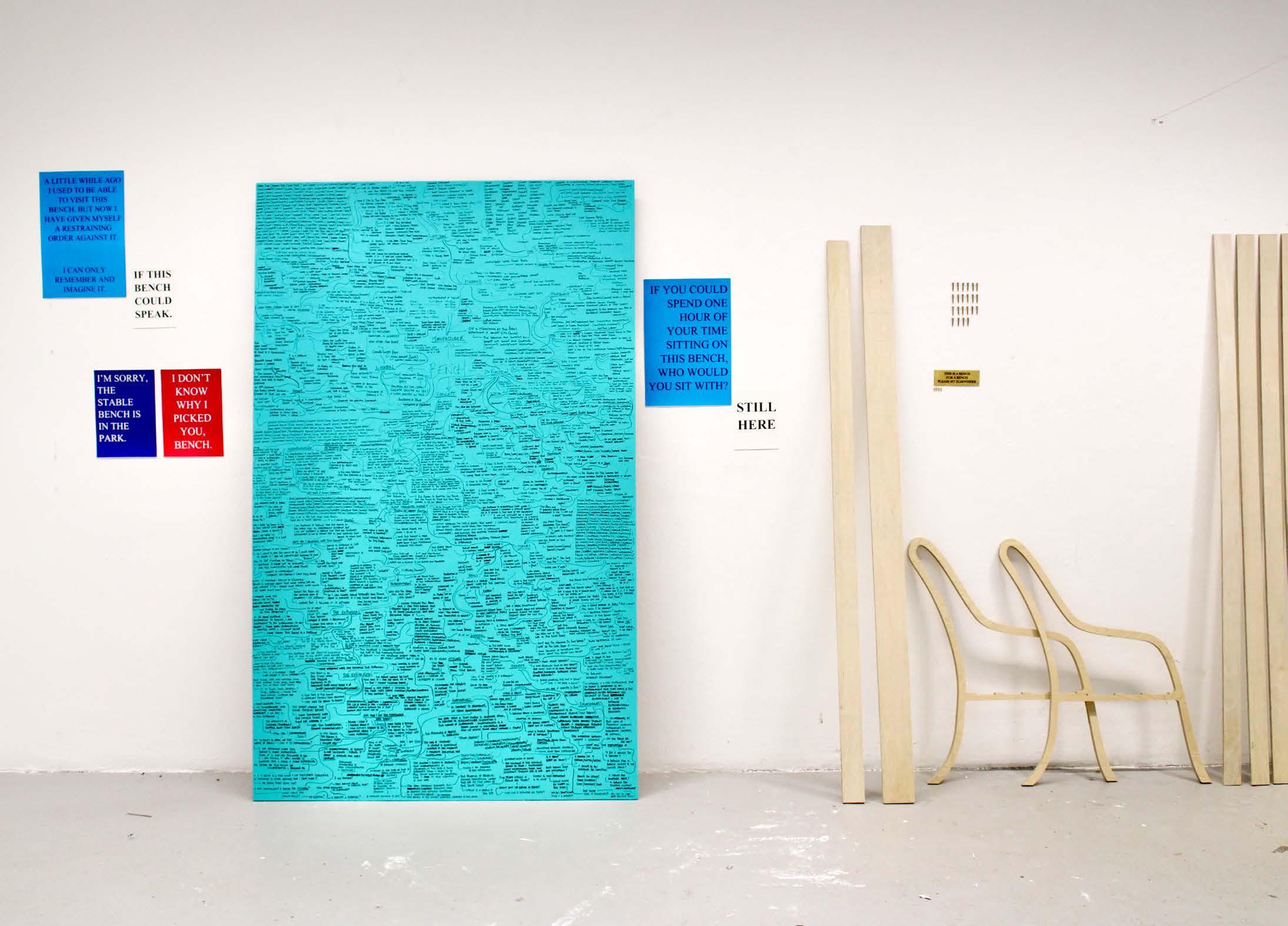
CLASS OF 2020 Student art: “Sincerity is in, glib humour out”
1
Katie Brunt (UWE, Bristol), Untitled, installation view, 2020
2
Francesca Manzin (Newcastle University), Geard, steel, approx 2x3m, 2020. Courtesy: Newcastle University
3
Lydia Makin (Slade School of Fine Art), studio space at Slade
As Brexit gives way to Covid-19 as the defining factor shaping all our futures, Chris Sharratt asks lecturers and course leaders about the kind of art this year’s graduates are making.
“I think this stuff comes from an anxiety about our immediate future and how we might shape that.” Nick Fox, senior lecturer in fine art at Newcastle University, is talking about the kind of art his final-year students are making and why. It’s early March, and while the spectre of Covid-19 is a backdrop, its full impact is yet to hit. Instead, what is in the air as we chat is Brexit, Donald Trump, climate change, the general sense of global drift – reasons enough to be anxious. “For most of their education, Brexit has been a phantom that has become more and more real,” continues Fox. “And I think one of the things this general anxiety has been channelled towards is sincerity – sincerity is in, glib humour seems to be out.”
I’m talking to Fox because the extraordinary moment this year’s graduating students find themselves in – even before coronavirus – seems to beg an obvious and compelling question: what is on the minds of these (mostly) young new artists; what are they making art about? It’s something that Fox has clearly been taking note of across the work of the 55 students in their fourth and final year of BA Fine Art. Working in a variety of mediums including painting, sculpture and film, the students are, says Fox, “quite directly taking on political context”. Their work, he explains, is addressing issues of nationalism and identity
in relation to nationhood, along with broader concerns about social inequality, ideas around truth and false truths, notions of place and self identity. “Lots of students are working in quite socially-engaged ways,” he adds. “There also seems to be a renewed interest in the value of things, the value of materials and being able to say something with a form.” This nuanced, thoughtful approach to materials and their use is also observed by Wayne Lloyd, programme leader for BA Fine Art and BA Art & Visual Culture at UWE in Bristol. There are 60 students graduating this year across both courses and Lloyd acknowledges that their approach to art making has been profoundly affected by a feeling of uncertainty about the future. “The students seem to feel that they need to be light on their feet these days,” says Lloyd. “Not just in terms of the work they make, but in terms of not carrying so much cultural baggage around; to be able to move out into the world and be able to adapt to lots of unknown and unseen circumstances. I think there’s a feeling that they don’t really know how things are going to pan out, what sort of environment they’re going to be working in in a couple of years time. So fluidity and flexibility is important; they want to be prepared for any eventuality.” This desire to be able to respond quickly to situations, to not be hindered by physical and cultural restrictions, can be seen in the form the students’ artwork takes. Says Lloyd: “It’s work that is very much a visitor, work that is passing through. There’s a fluidity about it, not a monumental permanence. There’s a lot of work that’s very minimal, a lot using borrowed artefacts. There’s materiality, lightness and things that don’t impact a lot on the very immediate environment here at Spike Island [where the students’ studios are based and the degree show usually takes place].” Art always reflects the conditions it is made under – it’s impossible for it not to. But what’s interesting is how artists use this context; what they do with it. “Art practice has this ability to take something that already exists and look at it differently,” believes Paul Stewart, co-course leader for BA Fine Art at MIMA School of Art and Design in Middlesbrough.
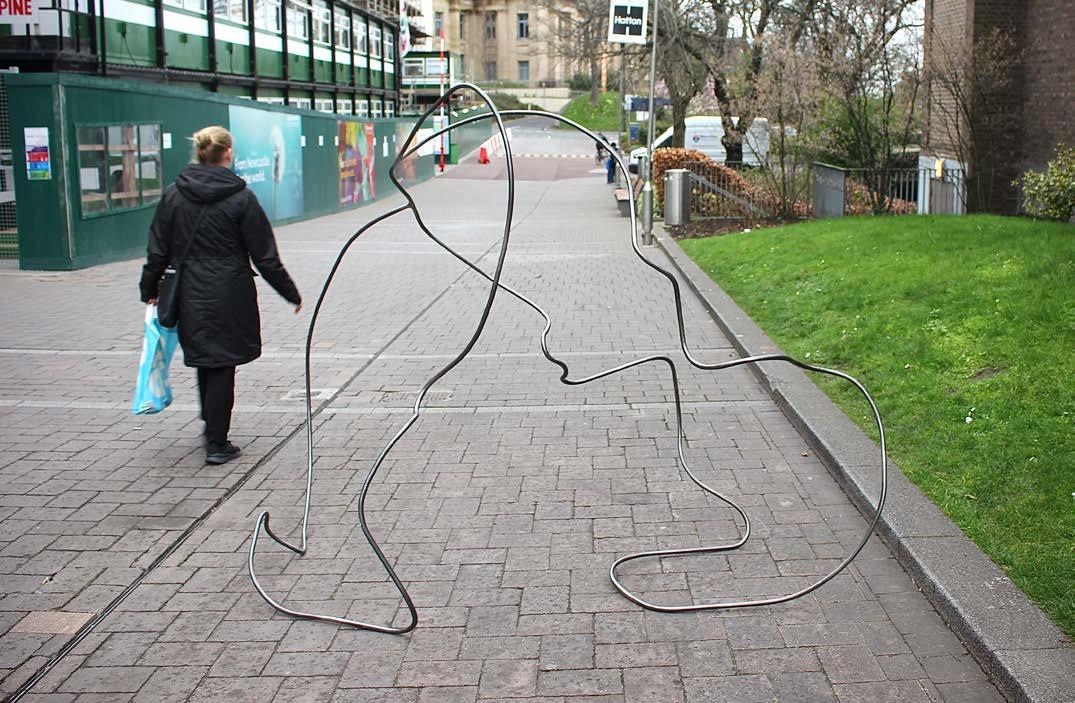
3
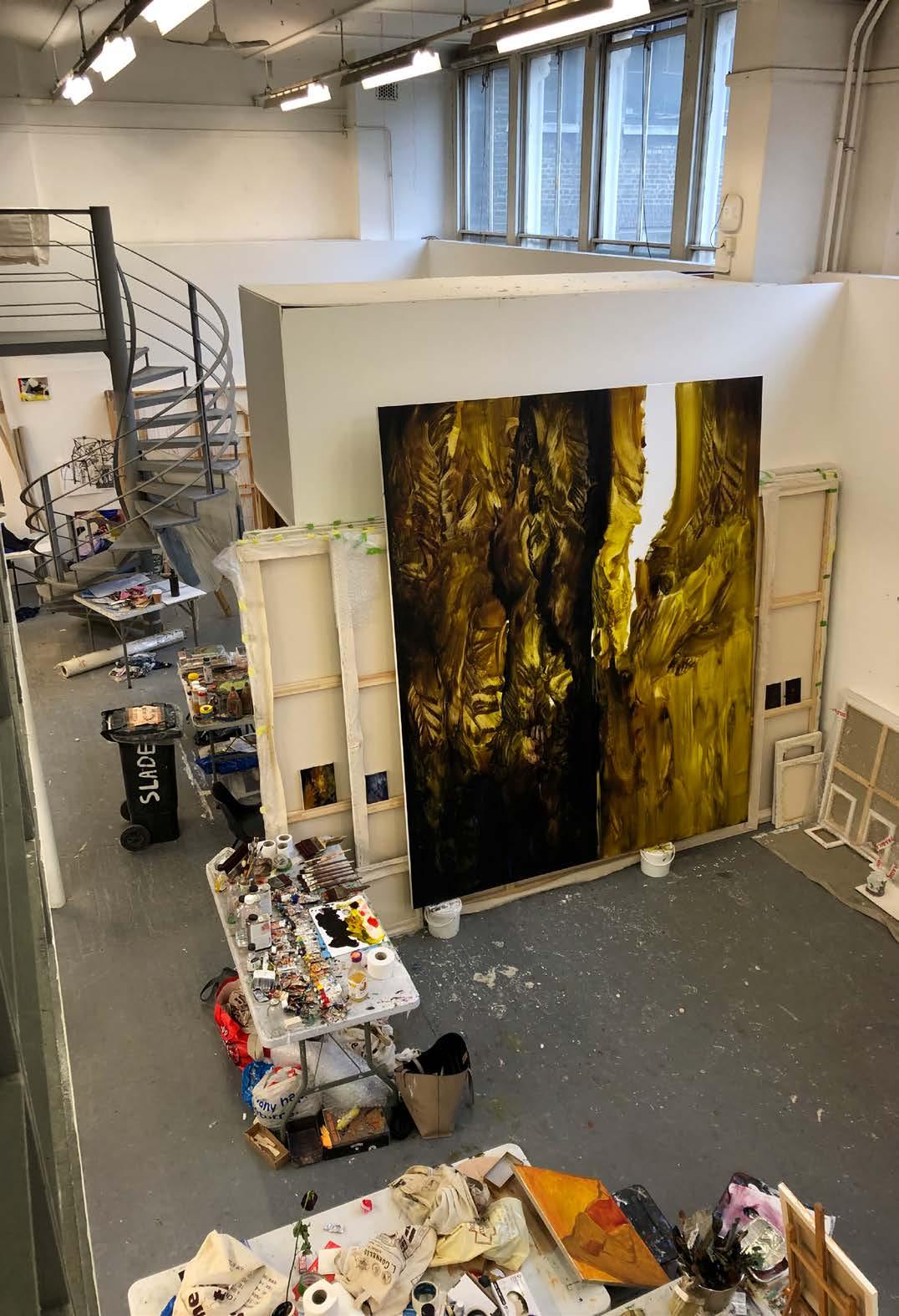
Like Fox and Lloyd, Stewart notes the impact of “an underlying uncertainty about what’s to come” on the work of the course’s 21 graduating students. This, he explains, sits alongside a strong interest in social relationships – a preoccupation that is clearly being brought into even sharper focus at this time of social distancing and self-imposed isolation. Stewart talks of a desire among his students to understand their own relationship with contemporary society – “the instantaneousness of their own experience” – and to seek to express this in their work. “There are lots of conversations around mental health,” he adds. He also detects an interesting relationship with the past and the passing of time – a complex interweaving of history, the present, and what might happen next. “There does seem to be a lean towards nostalgia, or time, or understanding time in some way,” he says. “For example, we have one student who is building a ‘time machine’ this year, another who is doing a lot of work around using family photographs to engage with an understanding of her own identity. Students are also using old ideas to go forward – we have a student who’s looking at Greek mythology, another looking at Victorian ideas of mourning in order to understand contemporary ideas of death or intimacy with immediate family.”
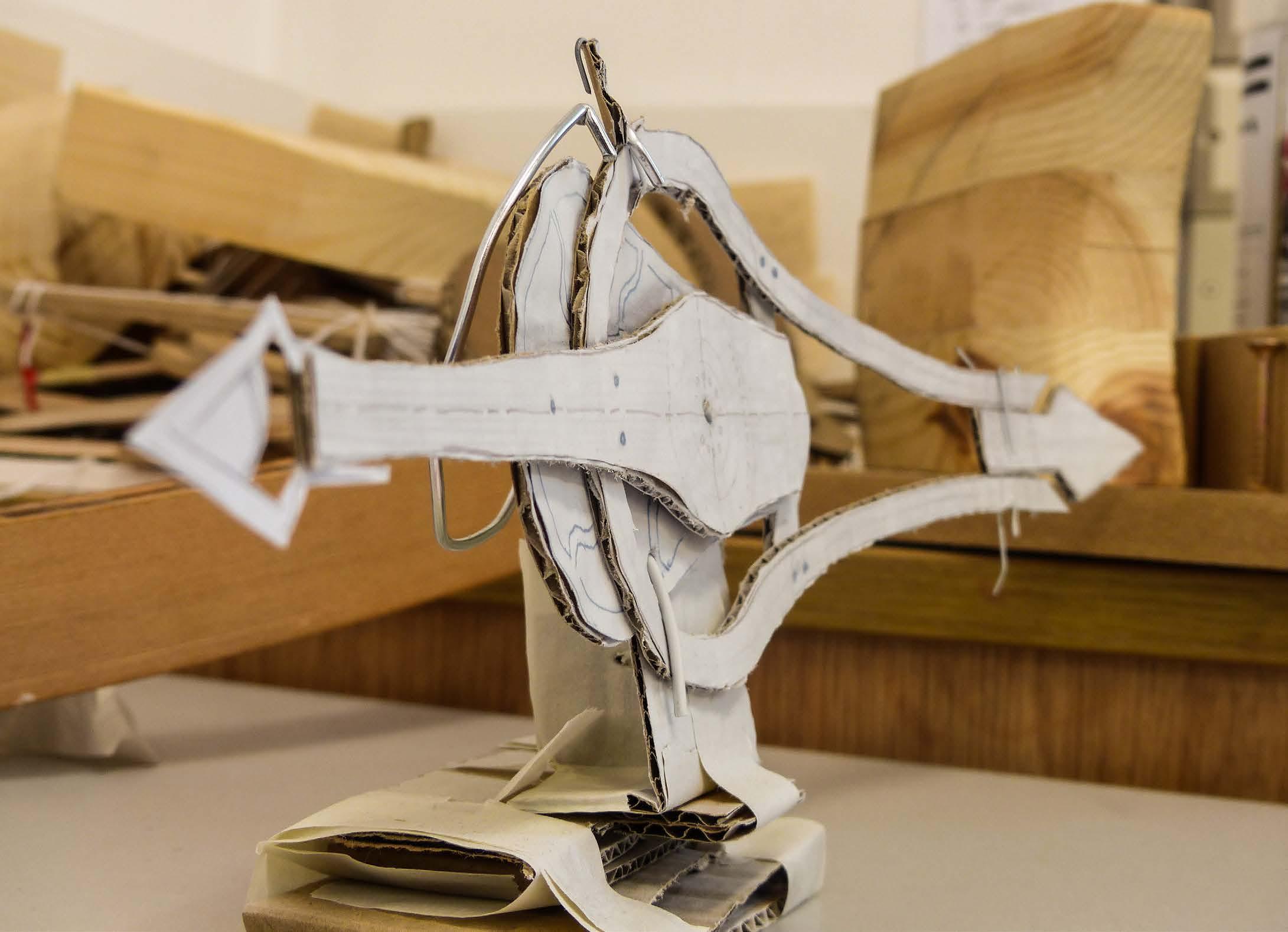
Drawing from the past, and specifically from the work of other artists, is of course all part of any art education. Andrew Stahl, professor of fine art and head of undergraduate painting at The Slade School of Fine Art, talks of the overlapping of historic and contemporary influences on his students, who are split across three specialisms: painting, sculpture, and media. “The Slade is just one gigantic argument about what contemporary art should be,” he says. Stahl is wary of assigning any particular themes to the 47 final-year BA and BFA students he teaches: “If there’s a theme it’s that there isn’t a theme.” But as we chat more, he acknowledges that the students are “hugely aware” of political issues, and that this seeps into their work, permeating it in subtle, barely acknowledged ways. “The question the students have to face is do I ‘exploit’ this for my own career? Do I use this in an obvious way or is this something I need to consider and work out? I think these are all issues in everybody’s minds. Some people feel they can’t deal with it, it’s too much or too literal, and others try to engage with it.” Our conversation is peppered with references to ecology and the environment, of the weirdness of the current political situation and the emotion and confusion around Brexit. All of this is having an impact on the art being made, but overtly political, banner waving work is not the result. Stahl, for example, cites the approach of one student who he describes as “ecologically-focused”. Rather than sloganeering, she “would gather material abandoned outside a museum and build artworks from it”. From the time I started talking to lecturers for this article to now, the world has been turned on its head. As I write, degree shows have been cancelled or postponed, and online alternatives proposed. As uncertainty is piled upon uncertainty, the 2020 cohort is graduating at a time of shuttered galleries and art world stasis. Their new ideas and nuanced responses to the world around them are needed more than ever.
Degree shows: MIMA School of Art and Design: Online plans in development, dates tbc. www.tees.ac.uk/schools/mima/
Newcastle University: Online plans in development; a physical show is planned for later in the year. www.instagram.com/newcastlefineart
UWE Bristol: Online plans in development, dates tbc. www1.uwe.ac.uk/cahe/artanddesign.aspx
Slade School of Fine Art: Details currently unconfirmed. www.ucl.ac.uk/slade/shows/2020



